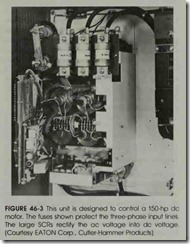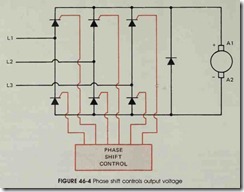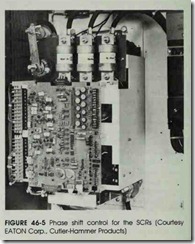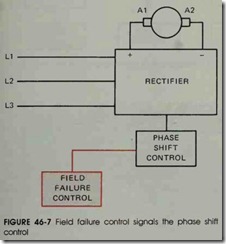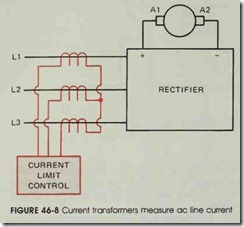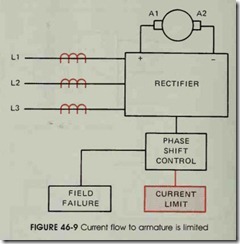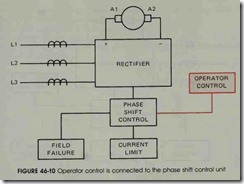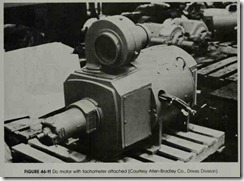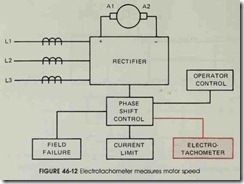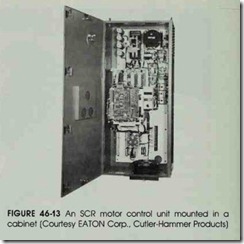Objectives
After studying this unit, the student will be able to:
• Describe armature control
• Discuss de voltage control with a three-phase bridge rectifier
• Describe methods of current limit control
• Discuss feedback for constant speed control
Direct current motors are used throughout much of industry because of their ability to pro duce high torque at low speed, and because of their variable speed characteristics. De motors are generally operated at or below normal speed. Nor mal speed for a de motor is obtained by operating the motor with full rated voltage applied to the field and armature. The motor can be operated at below normal speed by applying rated voltage to the field and reduced voltage to the armature.
In unit 45, resistance was connected in series with the armature to limit current and, therefore, speed. Although this method does work and was used in industry for many years, it is seldom used today. When resistance is used for speed control, much of the power applied to the circuit is wasted in heating the resistors, and the speed control of the motor is not smooth because resistance is taken out of the circuit in steps.
Speed control of a de motor is much smoother if two separate power supplies, which convert the ac voltage to de voltage, are used to control the motor instead of resistors connected in series with the armature, figure 46-1. Notice that one power supply is used to supply a constant voltage to the shunt field of the motor, and the other power supply is variable and supplies volt age to the armature only.
THE SHUNT FIELD POWER SUPPLY
Most solid-state de motor controllers provide a separate de power supply which is used to furnish excitation current to the shunt field. The shunt field of most industrial motors requires a current of only a few amps to excite the field mag nets; therefore, a small power supply can be used to fulfill this need. The shunt field power supply is generally designed to remain turned on even when the main (armature) power supply is turned off. If power is connected to the shunt field even when the motor is not operating, the shunt field will act as a small resistance heater for the motor. This heat helps prevent moisture from forming in the motor due to condensation.
THE ARMATURE POWER SUPPLY
The armature power supply is used to pro vide variable de voltage to the armature of the mo tor. This power supply is the heart of the solid state motor controller. Depending on the size and power rating of the controller, armature power supplies can be designed to produce from a few amps to hundreds of amps. Most of the solid-state motor controllers intended to provide the de power needed to operate large de motors convert three-phase ac voltage directly into de voltage with a three-phase bridge rectifier. (See figure 3-6.)
The diodes of the rectifier, however, are re placed with SCRs to provide control of the output voltage, figure 46-2. Figure 46-3 shows SCRs used for this type of de motor controller. A large diode is often connected across the output of the bridge. This diode is known as a freewheeling or kickback diode and is used to kill inductive spike voltages produced in the armature. If armature power is suddenly interrupted, the collapsing magnetic
field induces a high voltage into the armature windings. The diode is reverse biased when the power supply is operating under normal condi tions, but an induced voltage is opposite in polar ity to the applied voltage. This means the kick back diode will be forward biased to any voltage induced into the armature. Since a silicon diode has a voltage drop of .6 to .7 volts in the forward direction, a high voltage spike cannot be produced in the armature.
VOLTAGE CONTROL
Output voltage control is achieved by phase shifting the SCRs. The phase shift control unit de termines the output voltage of the rectifier, figure 46-4. Since the phase shift unit is the real control ler of the circuit, other sections of the circuit pro vide information to the phase shift control unit. Figure 46-5 shows a typical phase shift control unit.
FIELD FAILURE CONTROL
As stated previously, if current flow through the shunt field is interrupted, a compound wound, de motor will become a series motor and race to high speeds. Some method must be provided to disconnect the armature from the circuit in case current flow through the shunt field stops. Several methods can be used to sense current flow through the shunt field. In unit 45, a current relay was connected in series with the shunt field. A contact of the current relay was connected in series with the coil of a motor starter used to connect the armature to the power line. If current flow were stopped, the contact of the current relay would open causing the circuit of the motor starter coil to open.
Another method used to sense current flow is to connect a low value of resistance in series with the shunt field, figure 46-6. The voltage drop across the sense resistor is proportional to the cur rent flowing through the resistor (E = I x R). Since the sense resistor is connected in series with the shunt field, the current flow through the sense resistor must be the same as the current flow through the shunt field. A circuit can be designed to measure the voltage drop across the sense resis tor. If this voltage falls below a certain level, a signal is sent to the phase shift control unit and the SCRs are turned off, figure 46-7.
CURRENT LIMIT CONTROL
The armature of a large de motor has a very low resistance, typically less than one ohm. If the controller is turned on with full voltage applied to the armature, or if the motor stalls while full volt age is applied to the armature, a very large current will flow. This current can damage the armature of the motor or the electronic components of the controller. For this reason, most solid-state, de motor controls use some method to limit the cur rent to a safe value.
One method of sensing the current is to insert a low value of resistance in series with the arma ture circuit. The amount of voltage dropped across the sense resistor is proportional to the current flow through the resistor. When the voltage drop reaches a certain level, a signal is sent to the phase shift control telling it not to permit any more voltage to be applied to the armature.
When de motors of about 25 hp o: larger are to be controlled, resistance connected in series with the armature can cause problems. Therefore, another method of sensing armature current can be used, figure 46-8. In this circuit, current trans formers are connected to the ac input lines. The current supplied to the rectifier will be propor tional to the current supplied to the armature. When a predetermined amount of current is de tected by the current transformers, a signal is sent to the phase shift control telling it not to permit the voltage applied to the armature to increase, figure 46-9. This method of sensing the armature current has the advantage of not adding resistance to the armature circuit. Regardless of the method used, the current limit control signals the phase shift control, and the phase shift control limits the voltage applied to the armature.
SPEED CONTROL
The greatest advantage of using direct current motors is their variable speed characteristic. Al though the ability to change motor speed is often desirable, it is generally necessary that the motor maintain a constant speed once it has been set. For example, assume that a de motor can be ad justed to operate at any speed from 0 to 1800 rpm. Now assume that the operator has adjusted the motor to operate at 1200 rpm. The operator con trols are connected to the phase shift control unit, figure 46-10. If the operator desires to change speed, a signal is sent to the phase shift control unit and the phase shift control permits the volt age applied to the armature to increase or de crease.
De motors, like many other motors, will change speed if the load is changed. If the voltage connected to the armature remains constant, an increase in load will cause the motor speed to de crease, or a decrease in load will cause the motor speed to increase. Since the phase shift unit con trols the voltage applied to the armature, it can be used to control motor speed. If the motor speed is to be held constant, some means must be used to detect the speed of the motor. A very common method of detecting motor speed is with the use of an electrotachometer, figure 46-11. An electrota chometer is a small, permanent, magnet generator connected to the motor shaft. The output voltage of the generator is proportional to its speed. The output voltage of the generator is connected to the phase shift control unit, figure 46-12. If load is added to the motor, the motor speed will decrease. When the motor speed decreases, the output volt age of the electrotachometer drops. The phase shift unit detects the voltage drop of the tachom eter and increases the armature voltage until the tachometer voltage returns to the proper value.
If the load is removed, the motor speed will increase. An increase in motor speed causes an in crease in the output voltage of the tachometer. The phase shift unit detects the increase of ta chometer voltage and causes a decrease in the volt age applied to the armature. Electronic compo nents respond so fast that there is almost no no ticeable change in motor speed when load is added or removed. An SCR motor control unit is shown in figure 46-13.
REVIEW QUESTIONS
FIGURE 46-13 An SCR motor control unit mounted in a cabinet (Courtesy EATON Corp., Cutler-Hammer Products)
1. What electronic component is generally used to change the ac voltage into de
voltage in large de motor controllers?
2. Why is this component used instead of a diode?
3. What is a “freewheeling” or “kickback” diode?
4. Name two methods of sensing the current flow through the shunt field.
5. Name two methods of sensing armature current.
6. What unit controls the voltage applied to the armature?
7. What device is often used to sense motor speed?
8. If the motor speed decreases, does the output voltage of the electrotachometer increase or decrease?


